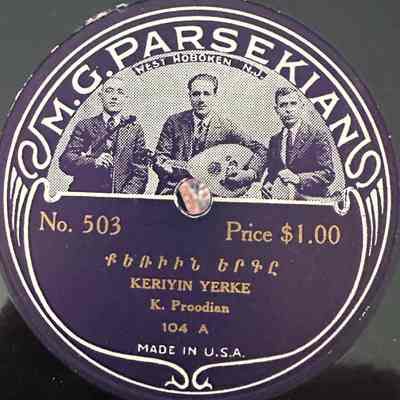Karekin Proodian, Keriyin Yerke/Khal Ellim

Name/Title
Karekin Proodian, Keriyin Yerke/Khal EllimDescription
In the early 1920s, Parsekian leveraged expiring disc recording patents to establish a recording label and manufacturing facility in West Hoboken (now Union City), NJ. Between 1923 and 1926, the label produced around 40 discs, with the first 30 recorded acoustically, without electricity or microphones. Karekin Proodian, born around 1884 in Diyarbakir, became the flagship artist for Parsekian’s label, recording nearly half of its catalog. After immigrating to the U.S. in 1903, he settled in West Hoboken, NJ, a community of fellow Dikranagerd natives, including Parsekian. Initially a photoengraver, he became a U.S. citizen in 1910, married Haiganoush Akmakjian, and returned to the U.S. with their son in 1912. The couple later had two more children, including Setrag, a future musician. Between February and December 1916, Proodian recorded 18 Turkish songs and one Armenian ballad for Columbia and Victor Records. In the 1920s, he adopted Hovsep Shamlian’s vision of presenting Anatolian music in Armenian, recording 18 Armenian and four Turkish songs for Parsekian. Proodian, Parsekian, and Shamlian formed a collaborative musical ecosystem: Parsekian managed production, Proodian provided vocals, and Shamlian composed. Most of Proodian's Armenian recordings featured Shamlian's compositions, with accompaniment from renowned musicians Harry Hasekian on violin and Edward Bashian on oud. Gamavor Kerin is a “fedayee song”, that is a ballad devoted to Armenian freedom fighters, in this case, Arshag Kavafian, a native of Erzurum who adopted the nom de guerre “Keri” (“Maternal Uncle”). The song is usually titled “Keriyin Yerke” (Keri’s Song), though Vartan’s title translates to “Volunteer Keri.” As told in the song, Keri commanded the 4th Battalion of the Armenian Volunteer (Gamavor) Troops in the Russian Army on the Caucasus Front during World War I, which after the fall of Tsarist Russia, became part of the military of the First Republic of Armenia. The casual listener will notice that Vartan employs an even more “Middle Eastern” vocal style in some ways in this song. That is because the fedayee ballads were typically written by wandering minstrels (“ashughs”) who sang in a declamatory style that had Middle Eastern influences. In this case, the song was written by one Ashugh Michaz, of whom we have little other information. Vartan’s presentation is in keeping with the Armenian minstrel style.Audio Format
78 RPM RecordRecording Type
MusicCategory
Vinyl Record

